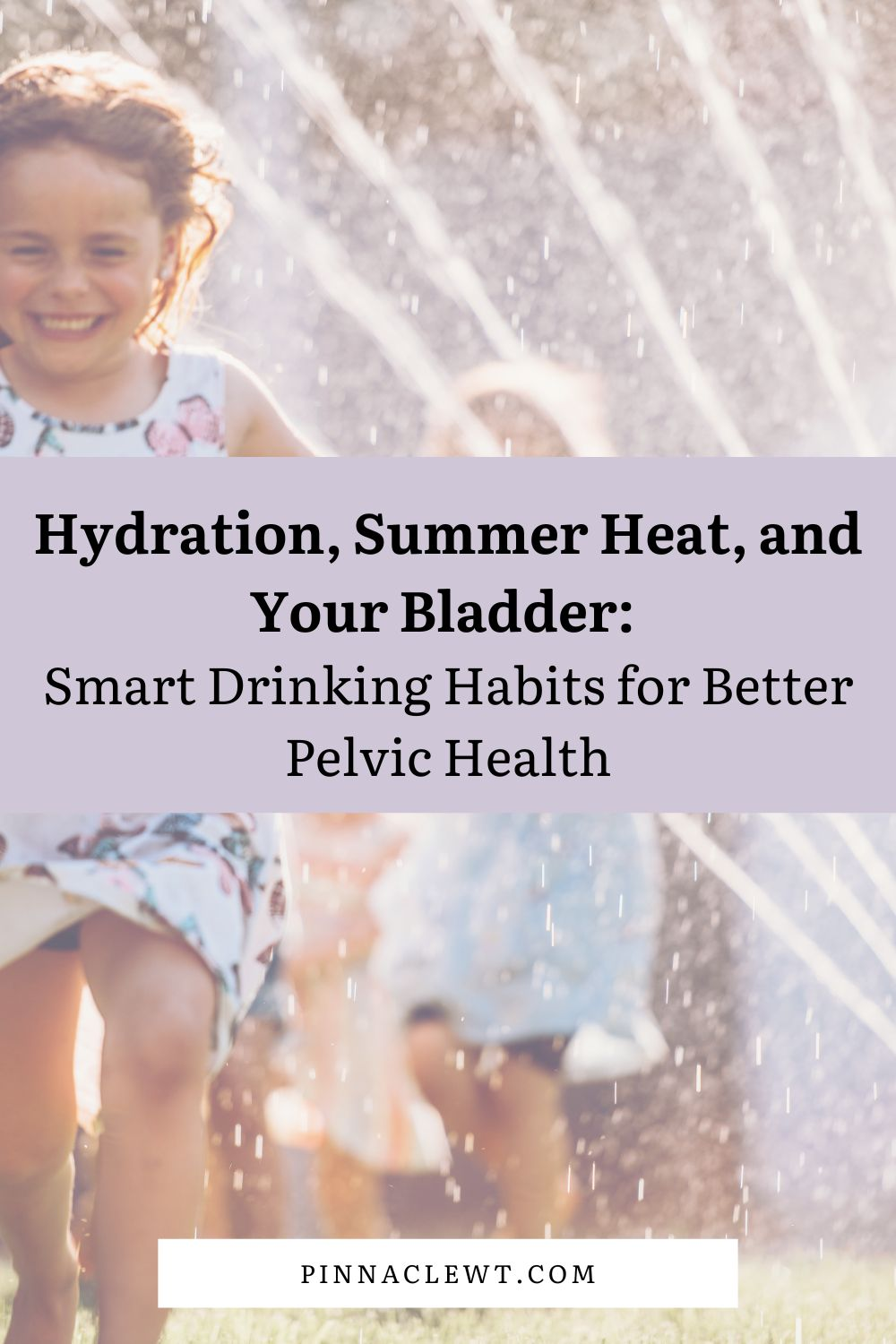When summer hits, hydration becomes top of mind—especially here in the Pacific Northwest where we savor every sun-filled day. We’re sweating more, spending more time outside, and trying to stay energized. But when it comes to pelvic health, how and when you hydrate matters just as much as how much you drink.
If you’ve ever chugged a water bottle after a hot day or felt like your bladder just couldn’t keep up, you’re not alone. Many of my patients are surprised to learn that sipping habits can play a huge role in symptoms like bladder urgency, frequency, and even leakage.
Let’s break down why hydration is a pillar of pelvic health—especially in the summer—and how to drink smarter to support your core, bladder, and whole-body wellness.
Common Summer Hydration Mistakes
During the summer, we tend to:
● Gulp water after a long stretch of not drinking anything
● Drink caffeinated iced coffees, teas, or sodas more often
● Skip water during busy outdoor activities
● Chug water before heading out somewhere to “be prepared”
● Forget to balance electrolytes, especially after sweating
All of these habits can put extra stress on the bladder—especially for those already dealing with pelvic floor dysfunction.
Why How You Hydrate Matters
Drinking a big glass of water all at once may feel productive, but it can overwhelm the bladder. That quick rush of fluid fills the bladder rapidly, triggering an urgency signal before your body’s ready. This is especially common for people with bladder sensitivity, urgency, or a history of pelvic floor tension.
Instead of gulping:
● Sip slowly throughout the day to give your kidneys and bladder time to process
● Use a straw or smaller water bottle to naturally pace your intake
● Set hourly reminders on your phone or watch if you tend to forget
And if you’re sweating? Don’t forget your electrolytes. Plain water alone may not rehydrate you if you’ve lost key minerals like sodium and magnesium through sweat. This is especially true for active women, moms, and anyone prone to fatigue, muscle cramps, or lightheadedness.
A Real-Life Example: When Less Water Made Things Worse
One of my patients filled out her intake paperwork noting that she drank only one glass of water per day—and one cup of coffee. I was sure it was a typo. But she confirmed it was true. She told me she had to urinate all the time and never felt thirsty. She also assumed drinking nmore water would make things worse.
In reality, her bladder was irritated—not from too much water, but from too little. Her urine wasnhighly concentrated, which made the bladder lining more reactive and triggered frequent urgency. Plus, that one daily cup of coffee was removing sodium from her body, further dehydrating her.
We took it slow. I guided her to start inspecting her urine color after each trip to the bathroom. If it was dark yellow or orange, we took that as a hydration cue. Our first goal? Simply drink enough to see lighter-colored urine—ideally pale yellow or almost clear.
Then we focused on how she drank: no chugging. Just slow, steady sipping throughout the day. We even talked about how she felt after drinking water: Did her urgency increase? Or did it improve once she was consistently hydrated?
Over time, her urgency reduced dramatically—and for the first time in years, she felt more in control of her body.
Hydration and Pelvic Floor Symptoms
Here’s how poor hydration habits show up in the clinic:
● Bladder urgency or frequency: Often tied to concentrated urine or chugging water
● Leaks or “not making it to the bathroom in time”: Overwhelmed bladder stretch receptors (which can be retrained over time).
● Pelvic pain or pressure: Made worse by caffeinated or carbonated drinks
● Constipation: Dehydration can directly cause constipation. We need water to hydrate and form healthy stools which should come out looking like a smooth banana, not hard pebbles.
● Muscle cramping or tension: Low electrolytes can keep the pelvic floor in a constant state of tension… and all muscles for that matter.
When we gently coach patients to improve hydration habits, they’re often amazed by how much their bladder and core symptoms improve—even before doing any formal exercises.
Summer Hydration Strategies for Pelvic Wellness
Let’s keep this simple and doable. Here’s how to hydrate smarter this season:
1. Sip, don’t gulp. Carry a water bottle and pace yourself through the day. Aim to sip every 30–60 minutes.
2. Focus on electrolytes, not just water. When it’s hot, plain water isn’t always enough. Add an electrolyte powder or tablet to 1–2 of your daily glasses.
???? I love Jigsaw Health electrolytes—they’re high quality, gentle on the system, and well balanced. Use code BUFFY10 for $10 off your first order: HERE. I really like the raspberry electrolyte supreme as well as the orange flavored potassium cocktail powder. And for superb hydration, energy, and immune support, I use their adrenal cocktail powder daily (sea salt, potassium and whole food vitamin C). Often in a shot glass with OJ as it is really salty in the best way!
3. Eat your hydration. Cucumbers, watermelon, berries, celery, and even smoothies can count toward your fluid intake.
4. Watch caffeine and carbonation. You don’t have to cut them out, but be mindful. Iced coffee, bubbly water, and energy drinks can irritate the bladder and increase urgency.
5. Don’t load up before bed. Try to stop hydrating about 1–2 hours before sleep to avoid overnight bathroom trips.
6. Make it visual. Use a water bottle with time markers or set a visual goal for the number of bottles per day.
When to Consider Pelvic Floor Therapy
If you:
● Pee “just in case” all the time
● Avoid long car rides or events because of bathroom access
● Leak when you drink too much water
● Constantly feel like your bladder is full
● Limit water out of fear it will make your symptoms worse
…it’s time to schedule a visit.
You don’t need to figure this out alone. As pelvic health therapists, we look at the full picture—how you hydrate, how you move, and how your pelvic floor is functioning.
Final Thoughts
Hydration isn’t just about hitting a magic number of ounces—it’s about rhythm, pacing, and listening to your body.
Whether you’re dealing with urgency, discomfort, or just want to feel more balanced and energized this summer, better hydration is a powerful first step.
Drink smart. Sip slow.
Buffy Stinchfield, PT
The Pelvic Health Coach & Founder, Pinnacle Women’s Therapeutics




